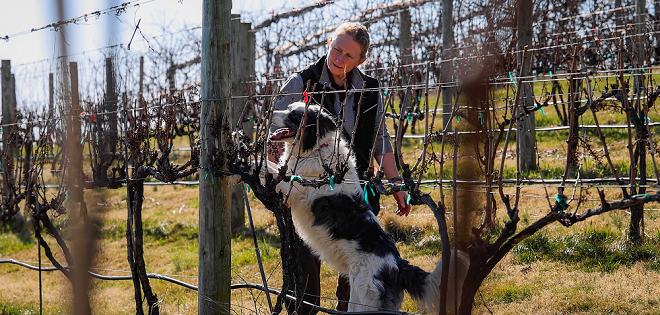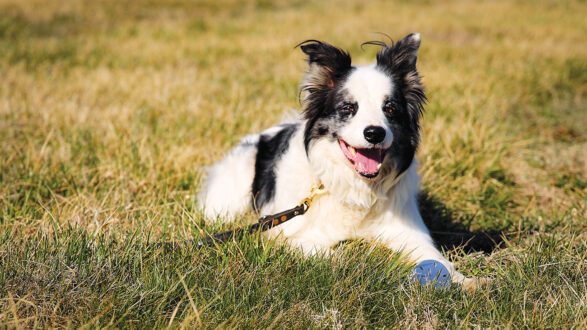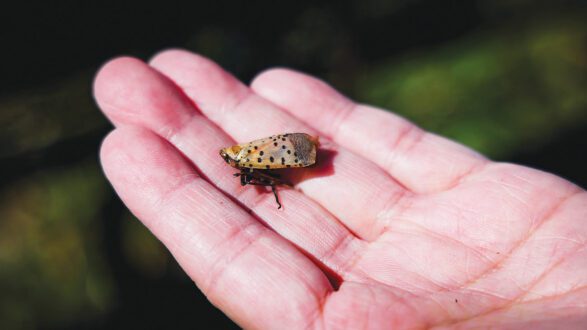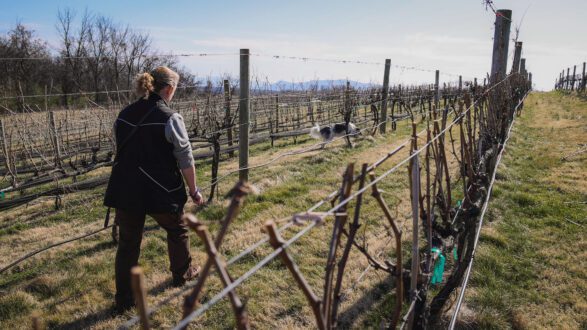
Jul 10, 2023The nose knows: Dogs find spotted lanternflies, other pests
Researchers are employing a novel approach to help growers discover and deal with spotted lanternflies (SLF).
Virginia Tech scientists are working with dog handlers to train canines to detect SLF, a destructive pest that feeds on a wide variety of crops and plants, including grapes, apples, cherries, nectarines, apricots, peaches and plums, as well as almond and walnut trees.
Researchers want to develop a network of citizen scientist dog handlers who can be dispatched to detect the latest invasive species.


“For SLF, we found that dogs can be trained to detect spotted lanternfly eggs, which can help us to detect eggs,” said Mizuho Nita, a Virginia Cooperative Extension specialist and an associate professor of plant pathology in VA Tech’s School for Plant and Environmental Sciences. “I think it is useful especially at the front of SLF movement since SLF lay eggs on many different surfaces, including stones and pallets.
”Unofficially called the Canine Citizen Science Study, the project is funded through a four-year $475,000 grant from the USDA’s Agriculture and Food Research Initiative. It began in 2021 at Texas Tech University’s Canine Olfaction Research and Education Laboratory and expanded to the East Coast, where SFL is prevalent.
At Virginia Tech’s Alson H. Smith Jr. Agricultural Research and Extension Center in Winchester, Virginia, scientists are asking dog owners to unite and employ their pets’ skills to sniff out SLF eggs.
SLF can be spread long distances through movement of infested material or items containing spotted lanternfly egg masses. Not limited to agriculture, SLF can also be a big nuisance to the landscape and residential industries.
The insect sucks sap, young stems and leaves, causing tree withering, reducing photosynthesis, weakening plants and eventually leading to plant death. Feeding causes plants to weep or ooze, creating a fermented odor. Trunks display a grayish-black trail of wounds. The insects excrete large amounts of honeydew, covering stems and leaves as well as the ground below infested plants.
Established populations in Pennsylvania vineyards have caused yield losses of up to 90%.
The nose knows
A canine’s sense of smell is equivalent to detecting a teaspoon of sugar in an Olympic-size swimming pool. Sally Dickinson, a Virginia Tech School of Animal Sciences doctoral candidate and a student of Erica Feuerbacher, an associate professor of applied animal welfare and behavior, owns and trains Flint, an 8 year-old border collie.
Canines can be useful where spotted lanternflies are about to enter, Nita said. SLF produce only one generation per year, so if researchers can effectively reduce the number of eggs spread by movement of products, they can slow its movement, Nita said.
“The detection will give people a heads-up to prepare for the upcoming season,” he said. “It takes about one to two years from the detection of the eggs or adults to the mass invasion. If you are a commercial grower, it will be enough time to make a plan.”
While detections are presently limited to the East Coast and eastern parts of the Midwest, SLF also poses threats to western regions.
“The West Coast should be very concerned about this pest because of numerous commercial crops, landscape plants, and wild hosts that could support SLF populations,” said Surendra Dara, entomologist and director and professor in Oregon State University’s North Willamette Research and Extension Center in Aurora, Oregon.
West Coast concern
SLF is the main reason for Dara’s outreach that began in 2014.
“California is especially at a higher risk because of the importance of grapes, peaches and other crops and the presence of SLF’s favorite host, the tree-of-heaven, distributed all over the state,” he said.
Because SLF hasn’t yet been detected in the West yet, no studies have been initiated for its detection or control, Dara said. Classical biocontrol studies in California suggest imported parasitoids or a pest’s natural enemies are not highly specific to SLF, so their release remains uncertain, Dara said. However, studies indicate that a parasitoid introduced for spongy moth control shows some native natural enemies attacking SLF.
“The best strategy right now is to be able to recognize SLF, do everything to prevent its introduction, and notify local authorities if you find one,” he said. Because several wild hosts favor the pest and since it can hitchhike on inanimate objects, SLF possesses a higher chance to spread, survive and multiply, Dara said.
“So, not just the farming community, but the general public should also be aware of this pest and its potential threat to their region,” he said.


To reduce pesticide use, early detection is critical. A key question researchers want to answer is when the bugs’ spores become available. By knowing the timing, scientists can adjust grower spray programs to protect grapevines.
“The challenge is when it sneaks in and causes damage on clusters,” Nita said. “Once clusters and berries are covered with powdery mildew, which can happen rather quickly, we will lose the crop.”
Researchers look to apply the canines’ work to other pests and diseases. SLF and grape powdery mildew pose significant threats for Virginia commercial grape growers. Powdery mildew, a disease that can be destructive when unmanaged, can spread quickly due to the nature of its reproduction. The researchers determined that dogs’ strong olfactory capabilities can detect powdery mildew better than humans, Nita said.
“I am hoping that we can expand the study to detect other economically important pests,” Nita said. “We picked powdery mildew because of its relatively obvious scent, but we may find dogs can sniff out other pests and diseases. I think it is worth exploring in the future.”
Growers can benefit from the canine work. Scouting a vineyard would take hours for a human, and dogs moving through the rows could save labor, Dickinson said in a video discussing the school’s research.
“I think one of the benefits is to show that your companion dog(s) can be trained to detect certain pests and diseases,” Nita said. “It may open up more opportunities for these talented dogs to ‘work’ on other projects. If dogs can detect certain pests, it will reduce the cost of detection, thus, it may directly reduce the operation costs for growers.”
SLFs have been detected in Virginia, Maryland, Pennsylvania, New Jersey, New York and New England. Smaller infestations have been reported in counties in Ohio, Michigan, Indiana, North Carolina and West Virginia. Quarantine zones are in place in Virginia, Maryland, Pennsylvania, Delaware and New Jersey.
Nita said the project is more about detection, not combatting the pest.
“For management, we do have other tools, but in order to have effective management, we need to find out what is causing the issue,” Nita said.
SLF can be managed through insecticides and culturally through traps. Netting can prevent large numbers of adults from establishing on vines, according to Virginia Tech Cooperative Extension. The dogs are also able to aid Virginia Department of Agriculture and Consumer Services survey crews who scout wooded areas for the SLF, Nita said.
— Doug Ohlemeier, assistant editor
Top photo: Virginia Tech scientists, including dog trainer and doctoral student Sally Dickinson, are examining how dogs can discover spotted lanternflies. The pest damages grapes and other crops, including apples, peaches, cucumbers and tree nuts. Photos courtesy of Virginia Tech.















